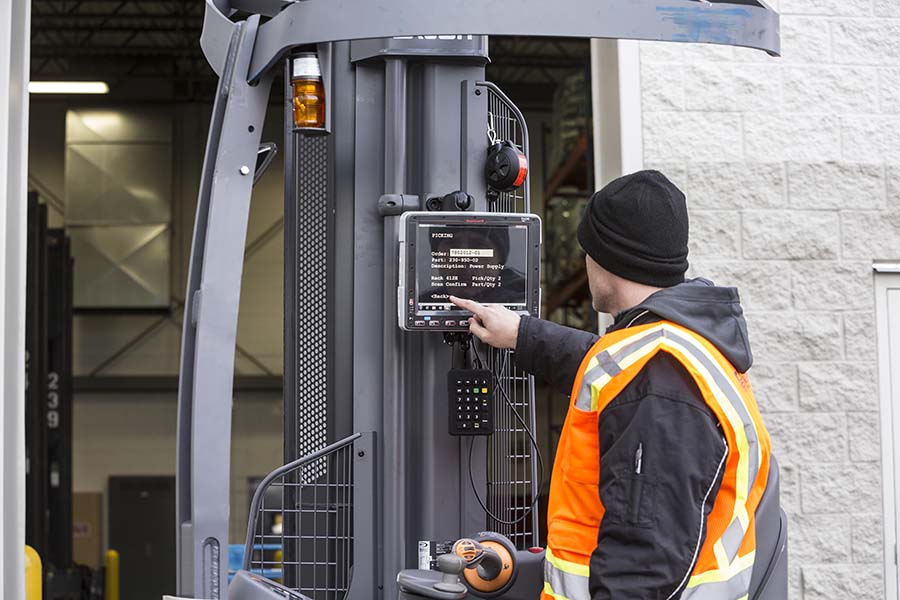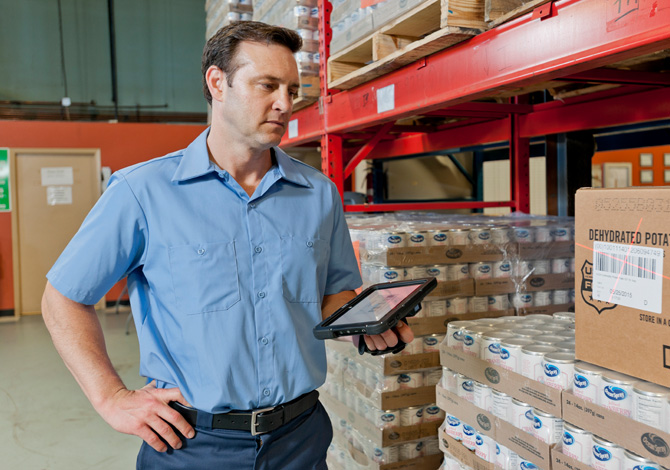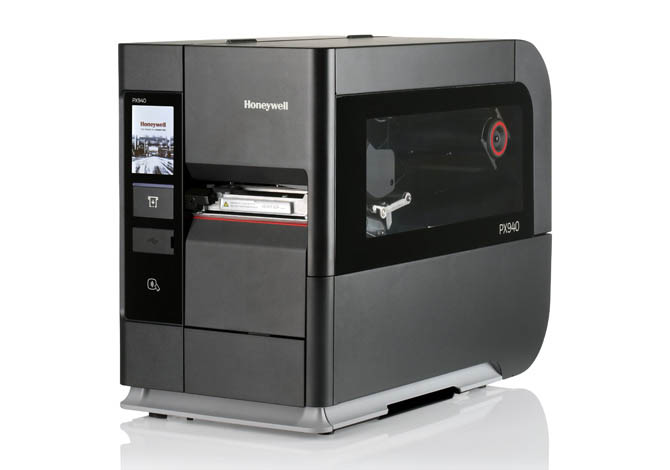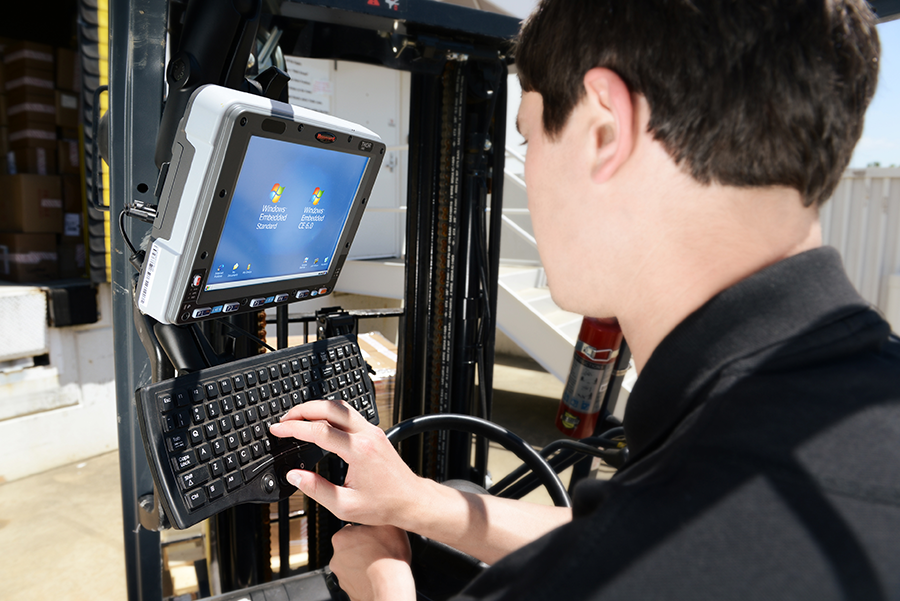by Chelsea Williams | Jul 7, 2019 | Uncategorized
Radio frequency identification (RFID) has rapidly gained momentum as a real-time tracking and locating technology for thousands of businesses worldwide. In this article, we take a look at RFID: what it is, what advantages it offers over barcoding, where it can be used, and how to determine if it’s a technology your company should consider.
What is RFID?
RFID stands for radio frequency identification. RFID uses radio waves, much like Wi-Fi does, to communicate between an RFID reader and an electronic tag, which is applied to an object. Each tag contains a wireless transmitter and is encoded with a unique identifier, which is tied to a database and used to identify the object and pinpoint its location to within a few feet.
When they come within range of the reader, tags are read wirelessly and automatically, even while they’re moving. The range of each reader is usually 5 to 10 feet, depending on your environment and your RFID tag types. But ranges can be adjusted and customized for your unique application needs.
RFID readers are usually handheld or mobile readers, or fixed readers installed at doorways or other strategic locations. Zebra is the top RFID hardware provider worldwide and provides solutions including readers, tag printers, and RFID antennas.
What are the advantages of RFID versus barcoding?
Unlike a barcode, you don’t need to line up a scanner to read an RFID tag. Tags are read wirelessly and remotely, even if they’re not physically visible or accessible. They’re readable as long as they’re within your reader’s radio range. You can read multiple tags at a time, so you can identify, track, and locate an entire room’s worth of inventory without manual, item-by-item scanning.
You can also use RFID for real-time tracking of assets as they move through processes or through different areas of a building, especially if you’re using fixed RFID readers at entryways or in aisles.
Where can RFID be used?
RFID can be used in any application where you need to identify, locate, and track products, assets, or shipments. It’s often used in warehouses, distribution centers, and retail to automate inventory and eliminate manual barcode scanning and cycle counts.
RFID is also commonly used in manufacturing for traceability and tracking of parts and materials as they are received, and as they move through production process and become finished goods. Hospitals are also using RFID to positively identify and track patients for better patient care and to avoid medication mix-ups.
How do I know if my company is ready for RFID?
RFID requires a significant investment, so consider your current processes, manpower, and budget, then determine how much you’ll potentially gain by automating your inventory, tracking, and traceability. Think about where you might potentially use RFID.
Compare the value of your potential gains to an estimated cost of an RFID deployment. To get a sense of costs and the hardware and infrastructure you’ll need, consult with an RFID technology provider such as our team at Informs.
Additionally, give some thought to whether you can devote the time to testing and training once you implement a system, and who will manage it.
What is the process for implementing RFID?
RFID should begin with a consultation with an RFID technology partner. This will usually involve site walkthroughs, process analysis, hardware recommendations, and a budget review. Once it’s time to launch a system, there will be testing, implementation, and deployment.
To learn more, get answers to your questions, and request a free consultation, contact our RFID experts at Informs to get started.

by Chelsea Williams | Jun 26, 2019 | Mobile Computing, Uncategorized, Warehousing
Windows had announced it is ending support for its Windows-embedded devices. This has caused manufacturing and warehouse operators to go on a frantic search for a new operating system (OS) for their enterprise mobile devices before the end-of-life goes into effect.
While transitioning to Android devices may seem overwhelming and complex, manufacturers such as Honeywell offer business solutions to take control and unify the process, effectively simplifying the transition. Honeywell built a mobile device platform to help navigate this transition: Mobility Edge.
Filled with cutting-edge solutions, download our complete product catalog here.
Here are just a few of the reasons why you should consider enterprise mobile devices built on the Mobility Edge platform:
A Unified Mobile Device Platform
The Honeywell Mobility Edge provides a unified hardware and software platform for all form factors, which allows for rapid deployments and great performance. Designed for Android, it is composed of common hardware, a common OS with support for multiple generations of Android, and a common software ecosystem that includes Honeywell software, as well as Honeywell-approved independent software vendors (ISVs).
Overall, this unified platform enables enterprises to streamline deployment and management for enterprise mobile devices, which improves efficiency and reduces cost, effort, and risk. It also helps to reduce the demands placed on the IT department.
Extended Lifecycle Means Less IT Frustration
Android enterprise devices, especially those built on the Mobility Edge platform from Honeywell, are renowned for their long lifecycles. In fact, enterprises can get six full years of life through 2025 when they invest in a Mobility Edge device from Honeywell. Not only that, but they can receive security support through the next five versions of Android.
The Mobility Edge platform also includes other features that extend the lifespan of enterprise mobile devices and provide a maximum return. The battery optimizer provides information about current charge and battery health. Users can choose different optimization profiles that can work to extend the available runtime of the battery pack. A self-diagnostics feature also allows users to identify and diagnose basic device issues, reducing the demand on IT.
Minimized Security Risks
An unmanaged device poses a security risk, which can be devastating to enterprises. When devices aren’t updated regularly and necessary security patches aren’t installed, cyber criminals have an opportunity to act, with some serious consequences. IBM reported the average cost of a security breach is up 6.4% to $3.86 million.
Honeywell provides regular security patches for Mobility Edge devices at least every 90 days—sometimes as frequently as every 30 days. This helps ensure that all devices on the Mobility Edge platform are secure, and data is protected.
Take Advantage of Honeywell’s Mobility Edge Platform
Honeywell is launching new enterprise mobile devices with the platform already installed. As the only company that guarantees support through Android R, Honeywell’s Android enterprise devices are future-proof and built to last.
- Dolphin CN80—an ultra-rugged device that features both a keypad and a large touchscreen interface for speedy and efficient data entry.
- Dolphin CT60—a durable and versatile mobile computer with a long-lasting battery and high-performance scanning.
- Dolphin CT40—a full-touch mobile computer with a five-inch display that acts as an intuitive tool, optimized for long shifts and comfortable use.
- Dolphin CK65—a rugged mobile computer with flexible data entry options and enhanced scanning read ranges of up to 15.2m (50 ft.).
- Thor VM1A—a leading vehicle-mounted computer that has been upgraded to the Mobility Edge platform, and can be used on multiple vehicles.
Interested in learning more about the enterprise mobile devices built on the Mobility Edge platform and how they can help you navigate the transition from Windows to Android? Contact Informs, Inc. today.

by Chelsea Williams | Jun 25, 2019 | Automated Solution, Operating System
3 Things to Consider when Transitioning from Windows CE End of Life to Android
Windows CE End of Life is near, leaving warehouses scrambling to find an alternate OS such as Android, that will allow them to continue maximizing productivity without experiencing downtime during the transition. A disruption in productivity can significantly affect your bottom line, so it’s important to find the right tools to keep your operations running smoothly.
Here are three things to consider when transitioning to Android.
Increased Productivity
When looking for a new vehicle-mount computer for your forklifts, your top priority should be finding one that will increase your productivity. The device you choose should be rugged, and able to withstand the conditions that it will need to work in, as well as the vibrations from the machine itself.
With Windows CE End of Life approaching, it’s important to find a new device soon, but don’t compromise on power. The device needs to have the capabilities to run any applications you need, without waiting for pages to load or data to process. Any device that runs too slow will dampen your productivity.
Another way to streamline operations and increase productivity is through error reduction. When your workers don’t have access to the data they need at all times, the time they spend retrieving it can cause huge delays. If they don’t have the time, they may try to go without, risking errors popping up. Prevent this by transitioning to Android devices built to perform and provide all necessary data instantly.
Lower Cost of Ownership
Many warehouse operators make the unfortunate mistake of never looking beyond the initial investment, but what you really need to consider is the total cost of ownership. Inexpensive solutions will always make you pay elsewhere with maintenance costs, planned obsolescence, or hidden fees.
Some may only be compatible with certain accessories, forcing you to purchase them instead of allowing to utilize the perfectly good ones you already have. Try to find products that offer backwards-compatible accessories, like docks, mounts, keyboards, and scanners to help you save money.
You also want to make sure your device is future-proof, with support in place for any upcoming Android updates.
Adopt a Platform to Prepare for the Future
Transitioning to Android-based devices can help ensure better warehouse productivity. With Honeywell’s Mobility Edge platform, you can get unified hardware and software architecture that makes it easy to deploy new devices and software applications.
The Mobility Edge takes an integrated and scalable approach to helping solve the Windows CE End of Life issue. Devices built on the Mobility Edge platform are ideal for simplified deployments and maximum productivity.
Consider a solution like the Thor VM1A, which is a compact, ergonomic solution that can accelerate provisioning, application certification, and deployment. It also features extended security update support, to maximize ROI.
Conclusion:
Windows CE End of Life is looming, but if you plan ahead and prepare, transitioning to Android devices doesn’t have to hurt your bottom line. The right technology, like devices built on the Mobility Edge platform, can help you easily navigate this transition and achieve higher productivity, while still providing a lower total cost of ownership.
Contact us for more information on Windows End of Life, and how we can help you avoid downtime and gain better productivity during this transition.

by Chelsea Williams | Jun 19, 2019 | Barcode Scanners, Warehousing
Unreadable barcodes are at best a nuisance, and at worst, a costly mistake that can cause major issues throughout the supply chain. Not only could your warehouse have heavy fines and charge backs levied against you, if you are a repeat offender, you may find your reputation is damaged.
To avoid this, warehouse operators can implement barcode verification systems to help eliminate unreadable barcodes and improve productivity within their operation.
Here are a few reasons why you may want to consider implementing barcode verification:
Eliminate Downtime
Bad barcodes have the potential hold up production. In a fast-paced industry like yours, this can cost you thousands, especially if it continues happening. Barcode verification processes ensure that each code is high-quality, and can easily be read and scanned. This eliminates costly downtime and helps save money on production costs.
You can further reduce errors by investing in quality printing equipment and supplies. Ensure you have the right media for your labels, and your print head stays well-maintained. Low-quality labels can scratch the print head, causing damage that result in unreadable labels. Incompatible media can cause barcodes to fade or smudge. Prevent issues like this from occurring by investing in high-quality consumables.
Save Money
Some operations are subject to costly back charges and fees from big box retailers. These retailers charge for inconvenience when items have unreadable barcodes. Over time, this can end up costing your operation more than you can afford.
Barcode verification can ensure you are printing accurate and readable barcodes, which eliminates these costly charges and fees. Again, ensure you are also using the right printing supplies. The adhesive needs to meet your needs and stick securely to the material you are attaching the labels to without leaving deposits or jamming up the printer. Your print head should always be clean and free of dust or residue.
Make sure your labels are also compliant with any applicable industry regulations, especially when it comes to the healthcare industry’s unique device identification (UDI) compliance regulation, which ensures products can be traced from manufacturing through disposal.
Choose Unsurpassed Accuracy in Your Barcode Printer
Choosing the right printer and barcode verification solution takes a lot of research, and the best option for you can depend on your individual needs. In general you want to make sure you look for a solution with high precision and accuracy. Look for a printer that can print labels in the size you need, clearly and accurately. This is especially important for those printing smaller barcode labels.
A quick way to ensure you achieve 100% accuracy every time is by choosing a printer with integrated label verification, like the Honeywell PX940 printer. The integrated label verification technology checks and ensures that your labels are accurate, notifying you of pass/fail status as soon as labels are printed.
Conclusion:
While no printer is 100% fail-safe, and you will always find some labels are unreadable, it doesn’t mean you have to damage your bottom line and cut your losses when this happens. Barcode verification can catch these errors before they are sent out, allowing you to avoid costly fees and keep your high-integrity reputation intact.
To learn even more about barcode verification, download The Manufacturer’s Guide to Barcode Verification here.
Informs offers innovative barcode verification solutions that ensure your barcodes are always readable and accurate. For more information on how barcode verification can help you improve your bottom line, contact us today.

by Chelsea Williams | Jun 12, 2019 | Manufacturing, Uncategorized
With heavy competition and rising consumer expectations, manufacturing businesses are on the lookout for ways to streamline their operations and improve manufacturing efficiency. Radio frequency identification (RFID) technology has proven to be an extremely effective solution, allowing workers to quickly identify and track assets by location throughout the supply chain.
Whereas barcode tracking requires a direct line of sight and can only provide a certain level of data, RFID readers can easily track everything within the vicinity, and provide information on assets with pinpoint accuracy.
If you are looking for a way to improve manufacturing efficiency within your operations, here are a few ways RFID can help:
Filled with cutting-edge solutions, download our complete product catalog here.
Inventory Management
RFID has made great strides in improving inventory accuracy and providing accurate counts. Rather than requiring manual inventory counts be made, RFID can take in a wider range of data much quicker. Since no direct line of sight is required, you can complete inventory counts in mere minutes.
Strategically placing RFID readers around your warehouse allows you to keep track of progress. This can improve manufacturing efficiency while providing real-time visibility into inventory levels so you can easily monitor inventory levels and prevent against shrinkage. This is useful if you need to track expensive containers, pallets, or even individual assets. You get a real-time view of when products enter and leave your facility.
Workflow Optimization
RFID doesn’t require a direct line of sight, workers don’t have to go and manually find each barcode one by one to scan. By automating your data collection processes, you save on labor and virtually eliminate human error.
When you place sensors at the door, you can enable workers to drive forklifts full of inventory and assets into your warehouse, and it automatically scans all RFID tags as items pass through your doors. Since no direct line of sight is needed, inventory items don’t have to be counted and scanned one-by-one. RFID tags could effectively replace barcode labels so that you can easily collect data and improve manufacturing efficiency through warehouse automation.
Asset Management
Unlike barcodes, RFID technology doesn’t just tell you whether or not an item has been received or is in stock, it also tells you the exact location, which further reduces inventory errors that could be caused by misplaced inventory and drastically improve manufacturing efficiency. The value of RFID increases with the value of the item being tracked, because this method improves both accuracy and security, while helping to increase productivity within your operation itself.
RFID sensors can be placed in a variety of areas around the warehouse, so the nearest sensor can tell workers where an order is located. This expedites the shipping process, because it allows inventory to be easily located without requiring workers to spend time tracking an order down and searching the entire warehouse for it if it isn’t in the correct place. Orders can be picked and shipped in minimal time.
Manufacturing solutions from Honeywell are great at helping boost efficiency, quality control, and workflow automation within your operation. This technology takes labor-intensive tasks and transforms them into simple, efficient processes driven by automation.
Interested in learning more about Honeywell’s manufacturing solutions and how RFID can improve manufacturing efficiency? Contact Informs, Inc. today!





Recent Comments